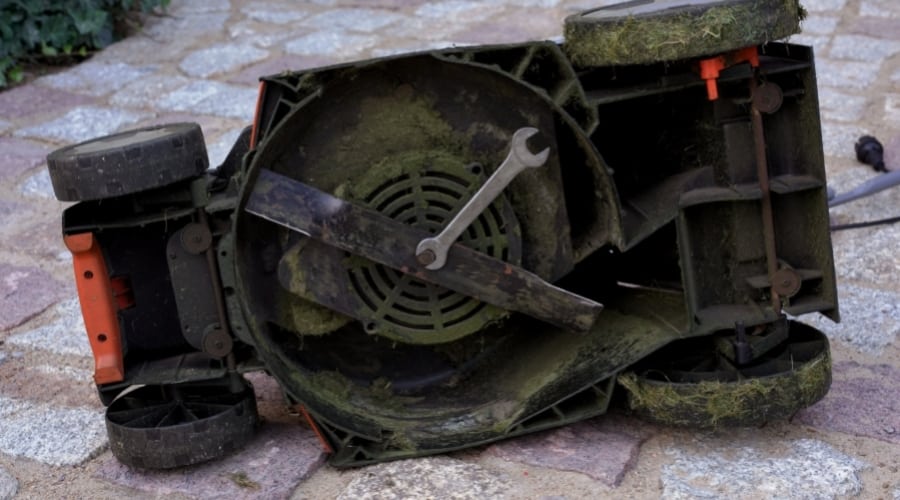The blades on lawnmowers are called deck blades, and they come in different shapes. Low lift, high lift, and mulching blades are all specialized types that cut lawns differently.
Regardless of style, the blades need occasional sharpening and replacement, which is why they have a nut in the center. Like a screw, retaining nuts are removable.
Are lawnmower blades reverse thread? I will explain why the direction those ridges spin matters more than you might think.
Table of Contents
Are Lawn Mower Blades Reverse Thread
Lawn mower blades are not threaded however the nut that holds the blade onto the drive shaft is. This nut is not reverse threaded on most lawn mowers. The direction you turn the retaining nut is standard to the right. A reverse thread nut won’t work because it will cause overtightening and significantly impact the cost for manufacturers.
Why Aren’t Lawn Mower Blades Reverse Threaded
Using reverse threaded retaining nuts could help secure blades on lawnmowers by using the natural action of the drive shaft to help keep them in place.
While this would help cut down on blades coming loose, it is not more effective than proper maintenance. Additionally, a nut that is always torqued against the motion of the machine would likely fail more frequently.
Sometimes a solution that appears practical is more trouble than it is worth.
If that’s not enough of a reason to avoid reverse threading on lawnmower retaining nuts, there is the issue of blade replacement to consider.
You cannot replace a blade if removing it is impossible. Reverse nuts would be far more challenging to get off of the mower, and it is already tough because they need to be very secure.
Since lawn mower blades wear out frequently, they often require replacement. A good, clean cut on your lawn is intimately tied to how sharp your blades are on the machine.
Reverse threaded lawn mowers are not practical. Everything you might gain from changing the nut direction is lost again in added costs, difficulty, and potential problems with overtightening.
How Do You Know If Your Lawn Mower Blade Is Reverse Thread
You can check the direction of your lawnmower blade nut threading by looking at it. By glancing down the driveshaft, you can see the nut will either be held in place by turning it in the opposite direction from the way the blades spin.
This “righty-tighty” twist is a standard thread.
When you look at a lawnmower from underneath, you can still see the direction the nut spins. If it’s difficult to determine based on looks, there’s a second way to tell.
Grab a wrench and loosen the bolt. Doing this will quickly show you whether it turns clockwise or counterclockwise. However, you can anticipate that it will unscrew to the left or counterclockwise.
The easy way to remember which one is ‘standard,’ is to recall the old saying about screws. “Righty tighty, lefty loosey.”
If you twist the nut to the right to remove it, it’s reverse threaded. In this case, both the nut and the place where it attaches to the drive shaft are effectively backward compared to most threaded parts.
Finding a reverse thread is so uncommon that it’s more likely an owner manually replaced the part after coming off the assembly line.
Lawn Mower Blade Bolt Direction
There are many confusing and contradictory ‘facts’ on the internet about the reverse threads on mower blades.
Although it could be helpful to have a reverse thread, it’s not necessary for the machine’s proper functioning.
Moreover, the challenges of this style of attachment outweigh any benefits. Simply put, most nuts (on anything) are set up for the standard, righty-tighty configuration.
Each lawn mower brand has its own standards. Moreover, within the brand, different models offer different features and can vary significantly.
On the list below I will walk you through some of the most common brands and models to show you examples of how the blades and bolts are set up.
Plus, I’ll share some tips and tricks for working with lawnmower blades and nuts.
Are Craftsman Lawn Mower Blades Reverse Thread
The Craftsman M125 Mower is a superb example of this brand. More importantly, these iconic red mowers are easy to work with.
To prevent any gas spillage as you work, unscrew the gas cap, place a plastic bag over it, and tighten the lid on top for a better seal. After that, you’re ready to turn the mower on its side and get to work.
Like all Craftsman Mowers, and the blade nuts are threaded standard and not reverse. One of the many convenient features of working with a Craftsman is the blade itself, which is easy to install.
A backward blade can damage your machine, so Craftsman marks the blade to indicate which side goes up.
Are Toro Lawn Mower Blades Reverse Thread
A Toro Recycler self-propelled mower comes with a lot of cool features like personal pacing. When it comes to blade replacement, the nut that holds it in is standard and not reverse threaded.
To swap this blade, you need to remove the wire from the sparkplug.
Ensuring that the engine is cool, you’ll need to tilt this mower on its side. A little gas or engine oil spillage is normal, so you may want to prepare by putting down a drop cloth or old newspaper before you tilt the machine.
You’ll also need to use some scrap wood to help hold the blade in place while using a socket to remove both the bolt and washer on this model.
Are Riding Lawn Mower Blades Reverse Thread
The popular Craftsman t110 riding mower is one of the most popular ride-ons around.
The size and weight of this machine make it impractical to avoid turn on its side like a smaller mower, so removing the deck is the best way to access the blades.
A manual for this model is easy to find online if you need help with deck removal. Once you have that out from under the main machine, you will need pliers to remove the clutch cable retainer and the spring before you can remove the blades.
However, the wrench will turn left to loosen. It is not reverse threaded.
Are John Deere Lawn Mower Blades Reverse Thread
As well known and loved as the Craftsman red are the green and yellows of a John Deere mower. The E110 is a great commercial mower used all over the country.
The dual blades are standard threaded and set side by side to give you excellent coverage as you mow.
To remove them, you will need to work on the blades and retaining nuts one at a time. However, to prevent accidents, it is a good idea to secure both blades before you start.
These heavy-duty cutters aren’t going to come out with a hand wrench. Grab a breaker bar to get the cutting blades off A John Deere.
Are Cub Cadet Lawn Mower Blades Reverse Thread
Cub Cadets are best known for their no-reverse blade safety feature. Although you can back up while driving, the blades will not engage in reverse because it is inherently unsafe to mow backward.
However, this doesn’t change the standard threading on the blades.
According to Club Cadet, the retainer nut on most blades “…is a standard right-handed thread (rotate clockwise to tighten, counterclockwise loosen) and should be tightened to between 70 and 90 foot-pounds of torque to fasten securely.”
Using a standard size and setup for all models it a common practice among mower manufacturers.
Are Honda Lawn Mower Blades Reverse Thread
Honda mowers use a two-blade system that gives your lawn a very smooth, even cut, but all Hondas are standard threaded and not reverse.
Models like the well-loved HRX come with the mulching option so you can cut your lawn and collect the mess as you go. If you don’t need mulch, use lawn trimmings to help bulk up a compost pile.
Are Ferris Mower Blades Reverse Thread
Changing Ferris mower blades is something you can do without flipping the machine at all. You will need a hand wrench to hold the spindle in place while you use a socket wrench to remove the nut.
The nut is not reverse threaded.
Though Ferris mowers often require a breaker bar to loosen, it is a good sign indicating they are built with tightly attached blades.
Helpful Tips To Know If Lawn Mower Blades Are Reverse Thread
- Looking at the bolt will tell you which direction the threads spin. If the threads angle up and to the right, it is a standard bolt, and the nut that fits on it will also be normal. These angles can be subtle, but they are always present.
- A non-reverse thread lawnmower bolt is the industry standard. However, if you have this type of mower, you must tighten the bolt properly and perform a quick check before you start mowing every time. It won’t take more than a few seconds and could save you a lot of trouble and expense.
- It is a common misconception that you can ‘just flip’ a nut to make it reverse thread. As AccuCo points out, turning it upside down doesn’t change the direction of the threads.
Final Thoughts
Despite the pervasive rumor that lawn mower blades are attached with a reverse threaded retaining nut, this is simply not the case.
Neither the brand nor style of mower matters in how the nuts are set up. From massive ride-ons to non-electric push mowers, it is likely they all have standard retaining nuts because they are easier to get and work with.
It would not be cost-effective for a lawnmower company to order custom reverse threaded nuts and bolts for mass production, especially when it’s likely to cause overtightening.
Doing this would increase the cost to the consumer unnecessarily and make maintenance more difficult.

